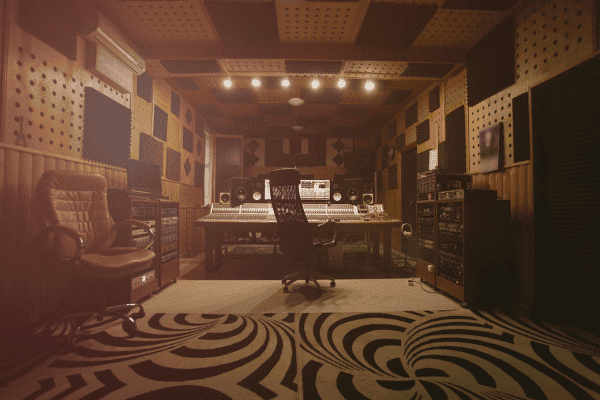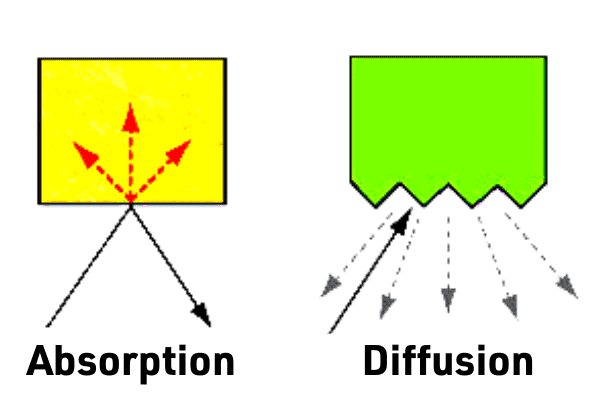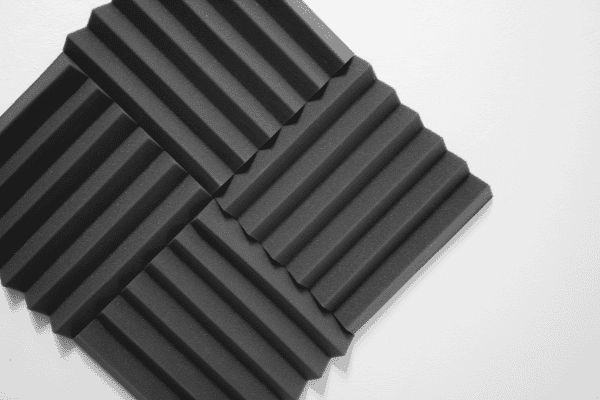If you’ve ever visited a recording studio, you’re probably aware that the walls in them are a little different than the walls in a home. They’re typically soft to the touch. But why do recording studios have these special walls?
Recording studios have special walls constructed to absorb sound and prevent echoes. Specific panels are also added to keep sound from wildly bouncing around studio rooms to maximize clarity and create the best possible recordings.
In this article, I’ll explain why recording studios have special walls, what materials are used to create these walls, and how they work to improve recording sound quality. Keep reading to learn more.

What Kind of Walls Do Recording Studios Have?
Recording studios have special walls that have been customized with acoustic treatment. This means that the walls are enhanced with specific materials, such as foam or fabric, to reduce sound reverberation and control the way sound moves.
Acoustic treatments help produce the ideal quality for sound recordings.
Of course, a recording studio also needs to be soundproof from all noise outside. This is very difficult to accomplish because everything from a room’s base construction to the materials covering the surface affects how sound moves. Hollow walls let sound through more effectively, for example. Hard surfaces make sound bounce and create lots of reverb in recordings.
This sounds very complicated because it approaches audio engineering territory, with lots of complex information about how sound moves through the air and interacts with various materials.
What Do Acoustic Treatments Do and Why Are They Important?
Acoustic treatments refer to how a room’s walls are constructed to absorb the different sounds. They’re vital to maximizing a studio’s sound recording quality.
Other reasons acoustic treatments are necessary for recording studios include:
- Reducing outside noises – studios are often located in urban areas with lots of outside noise like traffic, passersby, airplanes, PA systems, and more noisy distractions.
- Reducing noise from inside – there are a lot of noises inside the studio itself that you don’t want on a recording. These include A/C systems, keyboards, talking, fans, and more.
- Eliminating echoes – small spaces and hard walls especially are prone to producing echoes that can ruin a recording.
- Professional quality – studios are businesses that live by their reputation and sound quality. Whether you’re producing voice overs for television, recording music, or hosting a podcast, you want the best possible audio with no outside noises creeping into the sound.
How Sound Works
To understand how recording studios approach their wall construction, it helps to understand how sound behaves under certain conditions. When you know how sound works, you can customize the environment to best make use of sound’s characteristics.
Projection
Sound projection is how sound ‘sounds’ when you make it. The sound that goes from your voice to the microphone, for example, is called direct sound. This is what’s immediately heard through headphones in a studio.
Direct sound is only a small portion of where the sound goes, though – most of it goes to the walls and reflects off them according to their acoustic characteristics. If the walls are too hard, the sound reflects and causes the recording to sound ‘muddy.’
Direct sound is what you want for a recording, while any reflected sound is generally a nuisance. Different frequencies of sound call for different acoustic treatments – lots of curtains or foam in a room, for example, will reduce mid to high tones from bouncing, but the room will remain bassy or boomy.
Absorption and Diffusion
Sound absorption and diffusion are two sides of the same coin. Absorption traps sound and prevents it from traveling to the microphone, and diffusion scatters the sound and prevents it from being picked up by the microphone.
Absorbing and diffusing reflected sound is crucial when recording, especially in a small room. Sound bounces more in a small room and can produce more severe echo effects if precautions aren’t taken.

Reverberation
Reverberation is how long sound waves persist after they initially travel, e.g., how long an echo persists. Recording studios are ideally ‘dead’ in acoustic terms, which means reverberation is as short as possible. Reverberating sound makes recordings difficult to control because it’s picked up by the microphone.
Reverberation is mainly controlled by putting soft materials on the surfaces of the studio’s walls.
Decoupling
This isn’t an acoustic property so much as it’s a technique for reducing sound. Sound transfers through solid materials more easily than it does through the air, so solids directly touching will transmit sound.
When you decouple or separate materials, they transfer far less sound. Mainly, decoupling refers to constructing walls separate from the room’s framing in a way that adds a void or dead space between the walls. Sound won’t go through this void as easily as it would if the walls were touching.
Decoupling is a very effective fundamental way to keep external sound out of a room, but it’s expensive because it demands a specific method of construction – decoupling uses different studs or resilient channels than normal construction. Most professional recording studios will be constructed with decoupled walls, in addition to acoustic treatments.
Acoustic Materials
There are various ways to approach acoustic treatments. The base construction of the wall must be taken into consideration, but walls aren’t always built with the room’s sound in mind. This is where acoustic treatment materials come into play.
Foam
Most acoustic panels are made of some type of open-celled foam because it effectively kills undesirable sound from bouncing and negatively affecting recording quality. It also helps prevent outside sound from penetrating the room. Foam is mostly useful at absorbing mid to high frequencies.

Fabric
Fabric is often used to construct flat acoustic panels that absorb and diffuse sound. The material helps dampen ambient noise and create greater clarity in recordings. Fabric differs from foam in that it diffuses sound rather than absorbs it – this helps reduce excessive sound without completely deadening it. Fabric surface layers are also a great way to customize a studio without sacrificing sound quality.
Fiberglass
Fiberglass is often used as both a base panel for foam panels and as a primary material in its own right. It’s very efficient at absorbing interior and exterior sound and is the material of choice for most bass traps. It’s not too great for diffusing sound, though, and it can ‘deaden’ a room too much without foam overlay.
Acoustic Treatment Elements
Different parts of a studio call for different types of acoustic treatments in order to maximize desirable aspects of the sound and minimize undesirable aspects. Acoustic treatments can be used on top of decoupled walls for the best soundproofing.
Bass Traps
Bass traps are typically made of porous materials, because they absorb sound – most importantly, bass. Bass traps are very important because reflected bass frequencies are the most prominent in recordings. Most professional studios will at least use bass traps in the corners of the room, while some opt to cover the walls floor-to-ceiling in bass trap panels.
Bass traps are great in corners because when sound bounces, it’ll often hit the corners of a room. Bass trap panels are also an acceptable substitute for regular acoustic panels, such as in the case of a small studio or a home studio. Bass traps feature thicker material because bass sounds have more sound energy, so thicker material is required to effectively absorb or diffuse it.

For more information, check out whether you need bass traps for vocal booths.
Acoustic Panels
Acoustic panels typically serve as the base layer of a studio. Because they’re used mainly to cover lots of surface area, they’re thinner and use less material per individual panel. Acoustic panels are good at absorbing a middle range of frequencies, while thicker foam can be optionally used as a surface overlay.
Diffusers
Diffusers are optional acoustic treatment panels that are often cut into distinct patterns. These patterns diffuse sound without completely removing the sound energy, which reduces echoes without deadening a room.
Diffusers aren’t really necessary if the room uses bass traps in conjunction with acoustic panels, but they remain useful in some situations if there’s still too much ambient sound in a room.
Can You Soundproof a Room Yourself?
You can soundproof a room yourself. Not everyone who records music has access to a professional studio and such places often cost lots of money per recording hour. Individuals who plan on recording a lot of audio may opt to retrofit an existing room in their home to make recordings.
While the sound quality of a home studio may not rival a professional studio, in many cases, it’ll be perfectly sufficient to produce a good-quality recording.
Choose an Ideal Room for Recording
The importance of choosing a good room when creating a home studio can’t be understated. You need to keep in mind various things when choosing what room to make a studio.
Keep these considerations in mind:
- Windows are a big no-no because they let too much outside noise in that can interfere with your recordings. If necessary, there are ways to seal windows to improve acoustic quality.
- Avoid rooms that share walls with loud rooms like the kitchen, living room, or laundry room.
- The size of the room doesn’t matter very much – in fact, the smaller the room, the less soundproofing material you need to gather and install.
- You’ll need enough room to put your sound equipment.
- Soundproofing aside, you’ll want to add lighting to create an atmosphere that gets you in a creative mood. All the soundproofing in the world won’t make a difference if the room feels like a jail cell!
Soundproof the Door
You would be surprised by how much sound can come through and around doors into an otherwise promising home studio. Thick doors don’t allow as much sound as thin doors – hollow doors can be filled with spray insulation, or you can just put soundproofing material over the door itself if that isn’t an option.
You should get door sweeps for the bottom of each side of the door as well, to reduce the amount of sound that can get in the room under the door.
Consider Cost-Effective Soundproofing Solutions
Ideally, you would buy professional-quality acoustic panels when making a home studio, but that can be too cost-prohibitive – you’re making a home studio to save money, right? With that in mind, I’ll be listing some budget-friendly (i.e., not professional) soundproofing materials you can use to improve sound quality in your studio.
Soundproofing ideas include:
- Heavy blankets, quilts, or mattresses for walls
- Thick carpeting
/rugs
for flooring
- Foam gaskets for outlets/windows/miscellaneous gaps
- Spray insulation for window gaps and doors (optional)
- Vinyl sheeting to cover walls
- Egg cartons or other styrofoam to cover walls
- Corkboard
- Yoga/gym mats
Don’t forget the ceiling, too – it won’t mean much for your studio if the walls are totally soundproof, but the ceiling isn’t. Any material good for soundproofing walls will also work for ceilings but will just be more tricky to install. Also, pay close attention to corners – if corners are uncovered, sound can still bounce there and muddy a recording.
If you’re a reader, floor-to-ceiling bookshelves filled with books are a surprisingly good way to help soundproof a room. Bookshelves and books add mass to a room, and mass lining a room’s walls will absorb external sound. Adding an extra layer of drywall to a room can also do the trick as far as adding mass.
There are special clear acoustic window coverings for windows that drastically limit external sound while still letting light through. This can be useful if you want natural lighting in the room but want the best acoustic quality possible.
Final Thoughts
Recording studios use special construction methods and acoustic treatments to control how sound travels in the room. This explains why the walls inside of recording studios are often made of foam or fabric, and are soft to the touch. These materials help preserve recording clarity and create the highest-quality recordings, while also soundproofing the room.
Sources
- IPR College of Creative Arts: Why do Recording Studios Need Acoustic Treatments?
- Soundproofing Company: What are the four elements of soundproofing?
Recent Posts
QuickTime is a vital app for many Mac users, and if you’ve recently bought a new microphone, you might wonder how to use it optimally. QuickTime cannot record audio content if it doesn’t have...
Every microphone leaves a unique signature on the quality of its output. If you’re a podcaster trying to melt your way into your audience’s hearts, a muddy, distorted recording won’t cut it....
